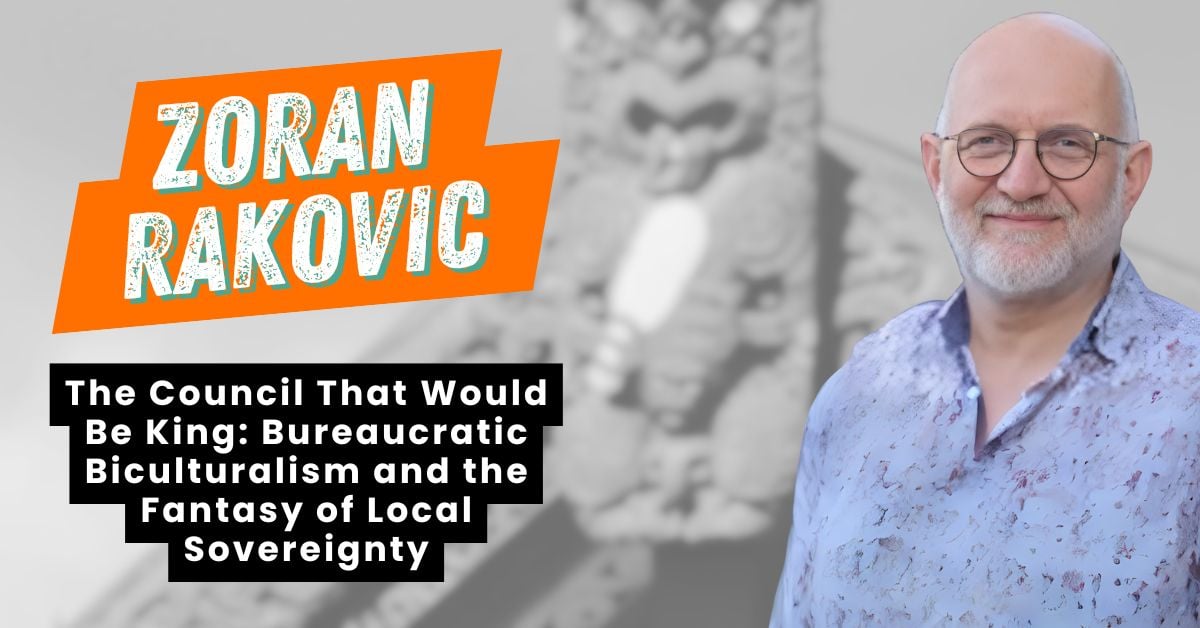
by Zoran Rakovic
There is a particular kind of madness that comes not with rage, but with the quiet clarity of a staff report. It arrives in a pdf, decorated with the warm tones of cultural respect, laced with enough Māori transliterations to soften the blow. Te Rautaki Tikaka Rua—Selwyn District Council’s Bicultural Strategy—comes bearing gifts: a house of four pou, a carved narrative ridgepole, a vision of treaty-based biculturalism that runs so deep it claims to restructure the institutional DNA of the district. But peel back the layers of “manaakitaka” and “tino rakatirataka,” and something uncanny is revealed: the document is a fantasy. More precisely, it is a fantasy in which a local council dresses up as the Crown, cosplays as a Treaty partner, and funds it all with your rates.
This is not biculturalism. It is bureaucratic ventriloquism.
To understand what is truly going on, we must begin with the obvious: under the New Zealand constitutional framework, it is the Crown that is party to Te Tiriti o Waitangi. Not councils. Not school boards. Not quangos. The Treaty binds the sovereign and the rangatira, not the mayor and the ratepayer. Yet this document proclaims Selwyn District Council to be a “Treaty partner,” a role it repeats again and again like a mantra. The effect is intoxicating. Councillors become emissaries of reconciliation. Mid-level managers are reborn as cultural navigators. Regulatory teams are no longer enforcing the Building Act—they are enacting tino rangatiratanga. This, in Žižekian terms, is ideological transubstantiation: the wine of legal duties turned into the blood of decolonisation by the priesthood of policy advisors.
But why stop there? If a council can appoint itself Treaty partner, why not Supreme Court? Why not iwi? Why not the second coming of the Waitangi Tribunal itself? You see, what is at stake here is not just symbolic overreach. It is a quiet legal fiction, repackaged as strategic vision. The Local Government Act 2002 (LGA) is clear: councils must engage with Māori, they must take account of Te Tiriti principles—but they are not, and cannot be, Treaty partners in the constitutional sense. Section 4 of the LGA states the Crown must maintain Treaty responsibilities, not transfer them. Section 14 encourages councils to “acknowledge” the principles of the Treaty, but nowhere does it say that councils may assume the role of the Crown.
This strategy therefore stands on shaky legal foundations. It presumes a power that has not been delegated. It institutionalises obligations that cannot be discharged by a district authority. It conflates partnership with co-governance, and cultural respect with delegated sovereignty. This is ultra vires—not in the abstract sense of bad taste, but in the concrete legal sense of acting beyond the powers lawfully granted.
What is more troubling is the creeping corporatisation of identity. In a supreme irony, the very idea of tino rangatiratanga—the radical, indigenous assertion of self-determination—is here rendered as a performance target within Council’s HR policies. “Cultural leaders” will be cultivated, “bicultural confidence” will be embedded, “mana whenua narratives” will be integrated into planning workflows. The language of resistance is absorbed into the machinery of bureaucracy. The indigenous is no longer the Other; it is now a consultant on retainer.
To be clear, this is not a critique of Māori identity, Māori authority, or the Treaty. It is a critique of a system that instrumentalises Māori culture for the benefit of bureaucratic expansion. One begins to suspect that the real purpose of the document is not to serve mana whenua, but to serve the Council’s own self-image. It is not Ngāi Tahu asserting sovereignty—it is Selwyn District Council asserting cultural moral authority.
Observe how the document displaces sovereignty: “Mana whenua will determine their priorities, irrespective of Council’s priorities.” Very good. Then it adds: “Council will recognise and support this.” Very progressive. But then, in the fine print, Council will also fund it, monitor it, evaluate it, and use it to transform internal systems of recruitment, planning, infrastructure, libraries, parks, and civic events. The supposed withdrawal of power is, in fact, a doubling of it. Council does not surrender control; it rebrands it.
This strategy does not decentralise power. It centralises cultural interpretation. It trains Council officers not just to pave roads and collect rubbish, but to curate identity. It is in this that the Žižekian critique reveals its teeth: the most dangerous ideologies are not those that demand subjugation, but those that ask us to clap along while we are managed.
Consider the metaphor of Te Whare o Waikirikiri, “The House of Selwyn.” Here the district is imagined as a wharenui, a traditional Māori meeting house, with ridgepoles representing visionary values, posts embodying strategic pillars, and the porch extending confidently into the future. It is beautiful, poetic—and completely manufactured. The Selwyn District Council is not a wharenui. It is not an ancestor. It is not a living body. It is a statutory entity bound by the purposes of the LGA. To cloak itself in ancestral metaphor is to blur the line between spiritual narrative and regulatory authority. The document doesn’t merely romanticise biculturalism. It appropriates it.
And yet, the public is seduced. How could they not be? The strategy contains all the hallmarks of performative virtue: recognition, respect, inclusion. It promises to “normalise te reo,” to “embed tikanga Māori,” to ensure “mana whenua participation at all levels of governance.” To oppose it risks being cast as backward, or worse, racist. This is the genius of bureaucratic ideology—it makes critique look like treason. The council doesn’t say, “Trust us, we know best.” It says, “Trust us, we’re honouring the Treaty.” To challenge the programme is to challenge the sacred.
But someone must ask: who benefits? Certainly not the ratepayers, whose voices were never sought in this cultural re-engineering. Certainly not the Māori communities reduced to stakeholder panels and advisory groups. And certainly not the democratic process, which is quietly supplanted by negotiated protocol. If councils can begin to appoint non-elected representatives to committees with voting rights, remunerated as elected members, then we are no longer talking about cultural inclusion—we are talking about constitutional transformation, executed without a referendum, buried in strategy documents.
There is something Orwellian in the prose of this report. Every assertion of partnership conceals an expansion of administrative control. Every act of inclusion presumes a new managerial structure. “We are being good humans,” it declares—an affective appeal so absurd it belongs more in a cult manifesto than a civic strategy. Good humans, apparently, speak the right language, perform the correct rituals, and never, ever question the central premise.
The cruel irony is that, for all its fanfare, the strategy will likely achieve very little for the communities it purports to serve. It will produce consultants, workshops, communications plans, and cross-cultural audits. It will produce roles. It will produce a department. It will produce metrics of cultural engagement. But it will not deliver safe drinking water to marae, nor reduce intergenerational poverty, nor return land, nor change the fundamental distribution of power in New Zealand. In Žižek’s terms: it is ideology in its purest form—action designed to mask inaction.
So what is to be done? For starters, councils must remember what they are: local authorities, not miniature Ministries for Treaty Affairs. Their legal mandate is to enable democratic decision-making, deliver services, and act prudently with public funds. Nothing in the LGA authorises the rewriting of constitutional relationships. Nothing in the Treaty obliges ratepayers to pay for bicultural transformation plans that were never debated at the ballot box. And nothing in the principles of justice requires the wholesale reinvention of council identity as a cultural institution.
Biculturalism, properly understood, is a relationship between two entities: Māori and the Crown. It is not a branding exercise. It is not a competence framework. And it is certainly not a justification for bureaucratic aggrandisement. If councils genuinely wish to support Māori, they should do what the law allows: listen, engage, provide equitable services, and advocate upward to central government. But they should not usurp the role of the Crown and cloak it in the garb of community partnership.
Te Rautaki Tikaka Rua is a beautiful lie. It tells a story of unity and transformation, of respect and reconciliation. But beneath the carved facade lies a truth more mundane and more dangerous: the transformation of local government into a self-authorising moral authority, unchecked by law, unbounded by precedent, and unfunded by democratic consent.
In the end, perhaps the greatest risk is not legal, but cultural. When councils assume the role of Treaty partner, they dilute the very meaning of partnership. They turn it into a template. A workshop. A KPI. And in doing so, they do not honour Te Tiriti—they consume it.
Let us be clear. If this document had come from the Crown, we would demand scrutiny. If it had come from iwi, we would respect its autonomy. But coming from a council, it demands resistance. Not because it is too Māori—but because it is not Māori enough. It is bureaucracy, painted with the brush of biculturalism, selling us a future we never asked for, in a language we are not allowed to question.
Let Selwyn be Selwyn. Let the Crown be the Crown. And let the Treaty be what it was always meant to be: a sacred covenant—not a script for managerial theatre.
Originally published on To Make The Darkness Conscious.
